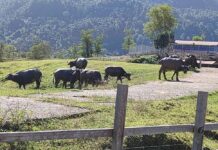SCIENTIST at Rothamsted Research received approval to sow one of the world’s first experimental field trials of a genome edited crop in an effort to develop more nutritious plants that can be sustainably grown.
The trial — the first to be conducted on genome edited (GE) plants in the United Kingdom crops as part of a trial to supercharge the plants to produce Omega 3 fish oils, one of the most popular food supplements.
The pilot was approved because, unlike genetically modified (GM) plants, the Camelina oilseed crops contain no foreign DNA. Instead, they had their genetic code altered in a way that could have happened naturally.
The pilot will investigate the efficiency of genome editing as a tool in developing plants that can deliver for the public good.
Like traditional plant breeding, genome editing can create new varieties of plants with desired traits by altering their genetic code in a way that could have happened naturally, without incorporating genes from another species.
But the new technology has a distinct advantage over traditional methods because it’s more precise and can dramatically cut development times, said Johnathan Napier, a leading pioneer in plant biotechnology at Rothamsted.
The GE varieties were produced by a technique known as CRISPR-Cas9.
Though the Cas9 protein that changed the plant’s genetic coding came from a different species, no remnants of the transgene are present in the final plant.
Another significant difference with the GE technology is that the genetic changes are expressed in every cell, in all parts of the plant.
The planting was approved by the UK’s Department for Environment, Food and Rural Affairs (Defra), which followed advice from its Advisory Committee on Releases to the Environment: “It would not be possible to determine whether these lines had been produced by genome-editing or by traditional mutagenesis because they would be genetically indistinguishable.”

















